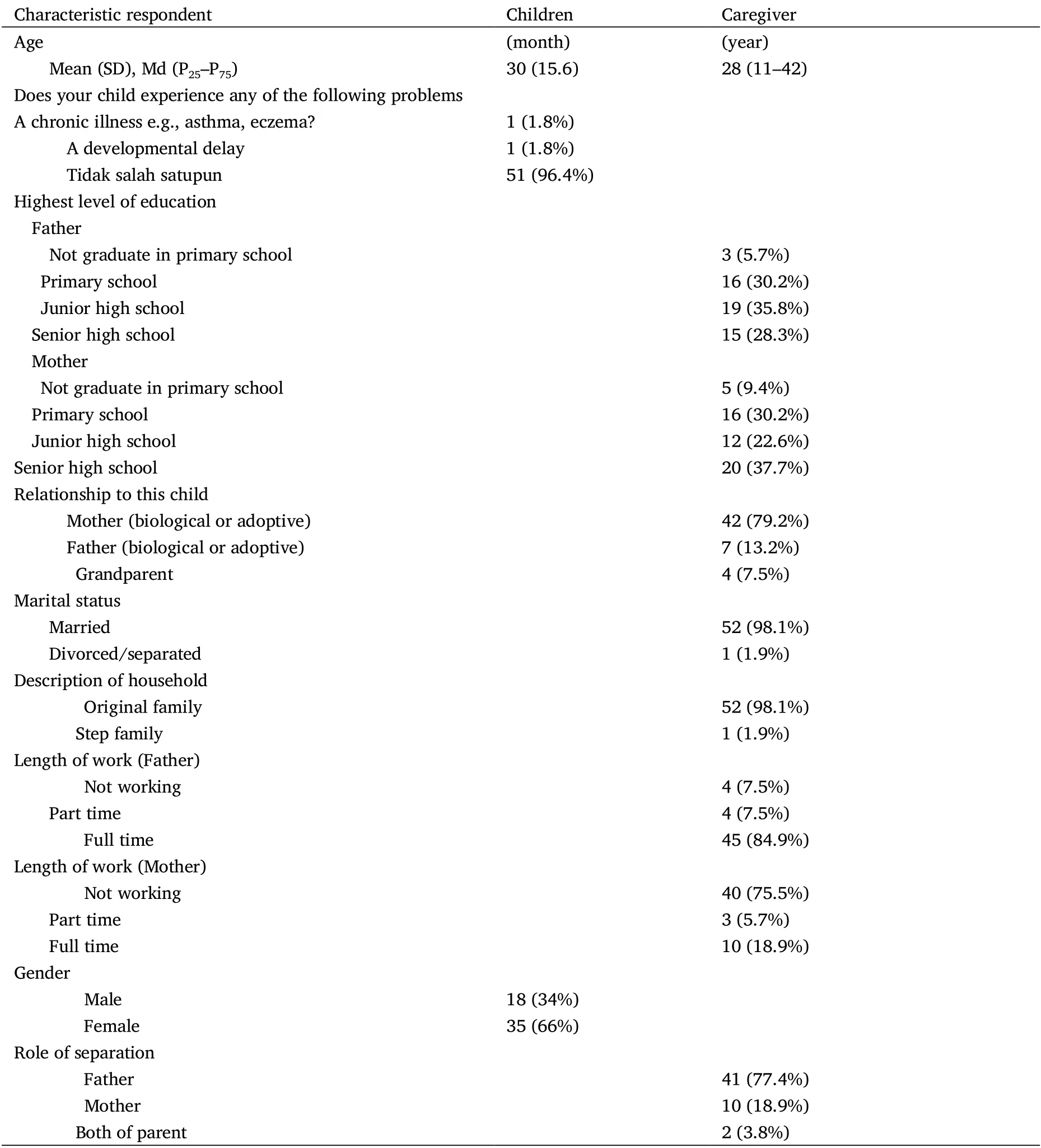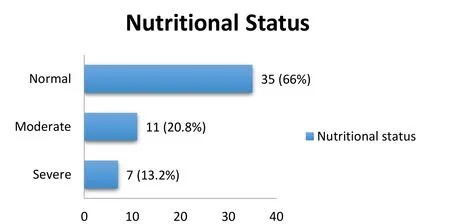The relationship of family separation and nutrition status among under-five children: a cross-sectional study in Panti Public Health Center, Jember Regency of East Java, Indonesia
Devi Nur Indah Sari, Tantut Susanto, Latifa Aini Susumaningrum
1Undergraduate Nursing Program, Faculty of Nursing, Universitas Jember, Indonesia. 2Department of Community, Family, Geriaric Nursing, Faculty of Nursing,
Abstract Background: Nowdays, both of parents are working to fulfill their family needs and family financial. However, this condition effected separation of family that have a negative impact for children. Children can lose of a primary caregiver who can endanger the welfare of children. Purpose: To analyzed the relationship between family separation and nutritional status of under‐five children aged in Panti District of Jember Regency. Methods: A cross‐sectional design was conducted among 53 families using total sampling. A family background questionnaire was used to measure sociodemographics and separation of family.Among 53 families were 78.2% of separation with father, while 38.6% of children with a good nutrition status. Kruskal Wallis and One‐Way Anova was performed to answer the objective of this study. Results: The result showed that, there were no correlation between length of separation with nutritional status (F = 0.377; P‐value = 0,688). Meanwhile,distance of separation was correlated with nutritional status (χ2 = 8.310; P ‐value = 0,016).Conclusion: Parents need to improve relationships, communication and the distribution of proper autonomy in family. It can make the nutritional status and health level of the child becomes better.
Keywords: family separation; nutritional status; under‐five children
Background
Nutrition problems in children aged 0–59 months in Indonesia in 2018 found 8% overweight, 6.7% moderate, and 3.5% severe. Where the results are different when compared to 2017, which is 4.6%overweight, 2.8% severe [1]. The nutritional status of children is affected by several factors, such as carbohydrate intake and a high percentage of food expenditure [2] working mothers [3] and the level of nutritional awareness in parents [4]. The condition of working parents causes the child to separated for some time from his parents and will have more influence on the incidence of malnutrition in children [5]. Therefore, the study of relationship of the separated family with nutritional status is important to the development task of the family, because the family has actively supported to development and growth of children in the future.
A separation is a life event that significantly risks negative consequences and the possibility of a worse life for parents and children [6]. Family separation can occur if parents and children never meet or live together for 75% of the child's age and within a radius of 50 Km [7]. Family separation caused by working parents can fulfill the needs of the family and increase the family's financial resources but can cause the child to lose the primary caregiver in the family [8]. Furthermore, family separation makes it difficult to manage parenting relationships [9]. During separation family,children will be cared for by caregivers who may be more permissive,pampering children or lacking discipline or can be too hard and neglecting the child [9]. Based on a study of family separation can affect the health status of children which includes physical and mental health as a result of pressure due to separation from parents [8].Therefore, family separation can influence and relate to the level of children's health, where one of them is the availability and adequacy of children's nutritional needs.
The success of fulfilling nutrition can be assessed from nutritional status by a balance between the amount of nutrient intake and the amount needed by the body that is used to carry out biological functions such as physical growth and development of activities to maintain health [10]. Meanwhile, the prevalence of malnutrition in infants in India is high when it is connecting with the health care of mothers give for their children [11]. Furthermore, the effectiveness of the mother's role as a caregiver for her child in family conditions without the father affects the nutritional status of the child [12].Meanwhile, problems of stunting and malnutrition in the Panti District, Jember Regency are still common. The result of the latest research showed that the Healthy Growth and Development Promotion Program for 144 toddlers in Panti showed stunting and malnutrition problems in the treatment and control group by 22.2%vs. 37.5% and 9.7% vs. 4.2% [13], where is the family has an important role in fulfilling the nutrition of children under five years[14]. Characteristics of family life in rural areas related with urbanization in productive age groups, especially men will be working in urban areas to supported family economy [15]. It will cause separation in the family.
Furthermore, the condition of the mother and father's role in the family and the separation of the family largely determine the nutritional status of toddlers. Meanwhile, the state of family separation is associated with the psychological problems of children under five years [16] and physical health of children [8]. Therefore,this aim of the study is to analyze the relationship between family separation and nutritional status in children under five years in the Panti Public Health Center, Jember Regency. The study of the relationship between family separation with the nutritional status of children under five is limited, therefore research is needed to make the family can do an active role in solving nutritional problems in infants through the functionality of the family as a single system. Therefore,the objective of this study was to identify separation in family,nutritional status of children under five years, and the relationship between family separation with the nutritional status of children under five.
Method
This research was conducted with a cross‐sectional study design carried out by home visits in the Panti Public Health Center, Jember Regency (December 2019–January 2020). The study population was families with children under five in the Panti Public Health Center,Jember Regency contributing 55 families. The inclusion criteria in this study included: (1) One or both parents are separated from their children for 75% of the child's aged from 4 months to 60 months; (2)One or both parents are separated by 50 Km or more. Subjects were excluded if (1) Toddler was not registered in the Integrated Healthcare Center data; (2) do not want to be a respondent; (3) Parents meet the child within 3 months before data collection; (4) caregivers are currently unable to communicate well (there is interference with speaking and listening); (5) Families separated due to death; (6)Toddlers with birth defects, toddlers born with low weight.
The researcher used Family Background Questionnaire to identify sociodemographic data of families and searation of family. WHO AnthroPlus BB/U analyzed to determine the z‐score. The measurement results are then classified using standard standards from the Ministry of Health of the Republic of Indonesia based on BB/U so that they can be divided into four categories, namely overweight, normal,moderate, and severe. The number of samples obtained in this study was 53 respondents determined using total sampling techniques. In this study, researchers visited the subject's house assisted by a local Integrated Healthcare Center.
The questionnaire was filled out using a Google form by the subject with the help of researchers. Data processing with SPSS 20.0, then performed data analysis with a Kruskal wallis if has an abnormal distribution and one way anova if has a normal distribution with a significance level (P< 0.05). This study was approved by the Health Research Ethics Committee of Faculty of Dentistry, Universitas Jember with Number 638/UN25.8/KEPK/DL/2019.
Results
The sample in this study were 53 families in Panti Public Health Center, Jember Regency. Family characteristics are shown in Table 1.
Indicators of family separation are the distance and length of separation. Based on Table 2 the distance of family separation has abnormal data distribution (P< 0.05) and the length of separation has normal data distribution (P> 0.05).
The indicators of nutritional status in children are the age of the child, the child's weight, and the Z‐score. Based on Table 3 the indicators of nutritional status in children. The age of the child has normal distribution, the child's weight has normal distribution and Z‐score has normal distribution.
From this study it was found that nutritional status was divided into severe nutrition, moderate nutrition and normal nutrition. As shown in Figure 1.
Based on Table 4 the distance of family separation shows a significant relationship with nutritional status in children under five years (P< 0.05).
Based on Table 5 length of separation family shows no relationship with nutritional status in children (P‐value > 0.05).
Discussion
This research was conducted on 53 separate families. Family separation occurs as a result of parents working in the city. There are several causes of urbanization such as the occurrence of industrial development it can expand employment opportunities, social factors(the attractiveness of cities), good living standards, and employment opportunities. Job opportunities in rural areas, people are more dependent on the agricultural sector. However, the agricultural sector depends on the season. In contrast to urban areas, where many job opportunities continue to attract rural communities in search of a better life [17]. The most recent education of fathers involved in this study was a junior high school (35.8%). The level of parental past education can affect the type of work that parents will have on the family's wealth status [18]. If the family has a high income, the family can be fulfilling the needs of the family's nutritional needs [19].
Based on a study stating that long‐distance relationships can affect not only two members of a partner, but can affect their children.Couples who experience separation due to family distance can use family therapy, family meetings with structured time to pay attention to children's education, personal problems, behavior, and improve emotional relationships and effective communication between parents and children. Also, special habits such as night telephone calls between parents and children can reduce the children's stress experienced due to separation [20].

Table 1 Family characteristics (n = 53)

Table 2 Distribution of indicators family separation

Table 3 Distribution of indicators nutritional status in children

Figure 1 Nutritional status in children

Table 4 Relationship between the distance of family separation and nutritonal status in children

Table 5 Relationship between the length of family separation and nutritonal status in Children
Nutritional status in children in Panti Public Health Center, Jember Regency shows varying nutritional status. Furthermore, the percentage of children who have normal nutrition, most compared to another nutritional status. That is because the primary caregiver in the family who became the respondent was a mother with a mean value of 28 years which included at a young age. A study states that mothers aged > 35 years are 1,523 times more likely to have a toddler with abnormal nutritional status compared to mothers aged < 35 years[21]. Besides, the age of under‐five years in this study has a mean value of 30 months. Malnutrition in young infants as well as in the womb can cause growth and development of the brain that is less than optimal which can affect the quality of human resources in the future.Toddlers who are at high risk have poor nutrition because of reduced breast milk intake and children's eating patterns that are difficult for their parents to control [22].
The result of research shows that the separation family in Panti Public Health Center, Jember Regency have a distance of separation> 50 Km. Based on the analysis with statistical tests there is a relationship between the distance of separation with the nutritional status of children (χ2= 8.310 danP‐value = 0,016). At a distance of 1.472.10 Km which is the largest median value lies in malnutrition with a range of 25–75 percent from 320.50 Km to 1,488.30 Km.Another study resulted that the separation of parents from children cannot be associated with the child's health status, but is associated with a good level of education of children and the behavior of children. Wherewith a distance of 75 km apart children have little possibility of committing a crime. Furthermore, in this study, the health status was more devoted to monitoring the incidence of hospitalization and focusing on the incidence of childbirth at a young age [23].
The results of this study indicate that there is no relationship between time and nutritional status in infants (P‐value > 0.05). In the duration of separation of families with children who experience malnutrition has the highest average value of 21 months. These results are different from research which states that the results of family separation can affect the health status of children which includes physical or mental health as a result of pressure due to separation from parents [8]. In line with research on factors that can affect the nutritional status of children one of which is the autonomy of the mother in the family, the study explained that the role of the mother as the primary caregiver in the family causes the mother to have great autonomy so the mother can participate in making major decisions and have control a large share of household resources as a result of great maternal autonomy can reduce the possibility of malnutrition in childhood [24]. Building relationships with other people or parents can reduce the negative impact of family separation due to parental migration. Also, high levels of communication between children and parents are associated with high levels of life satisfaction [25].
Conclusions
The conclusion of this study is there was no correlation between the length of separation with nutritional status. Meanwhile, a distance of separation was correlated with nutritional status Children Under‐Five Years in Panti Public Health Center, Jember Regency. The existence of this research is intended so that local health workers to facilitate families if there are doubts or problems related to decision making in caring for their toddlers, giving advice and motivating families to be able to improve the nutritional status of toddlers.
 Nursing Communications2022年13期
Nursing Communications2022年13期
- Nursing Communications的其它文章
- Delphi and Analytic hierarchy process for the construction of a risk assessment index system for post-stroke shoulder-hand syndrome
- A review of obstacles and facilitating factors of implementing Clinical Ladder Programs in nursing
- Spiritual health, empathy ability and their relationships with spiritual care perceptions among nursing students in China:A cross-sectional correlational study
- Qualitative study on influencing factors of refusal of gastric tube placement in stroke patients with dysphagia
- The influence of professional identity and ageism on turnover intention in nursing homes: a cross-sectional study from suzhou, China
- Nursing cooperation related to thoracoscopic surgery in children
